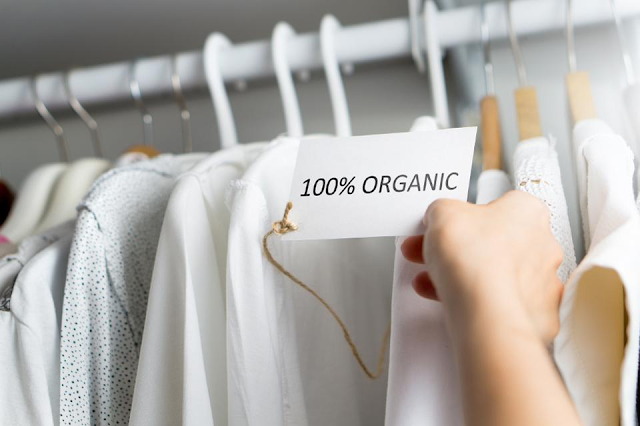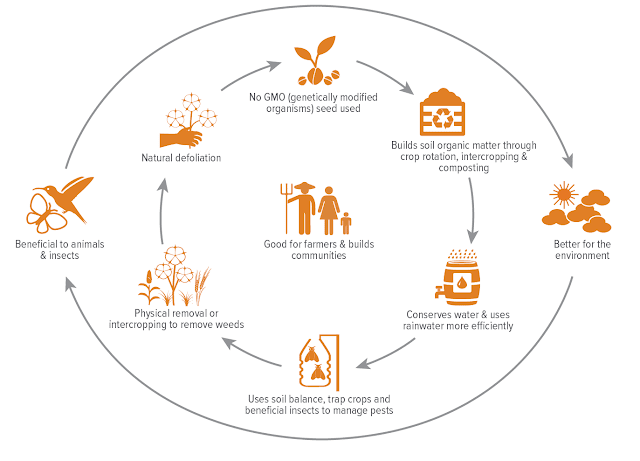Author: Dipanwita Ray
Fashion consumers have expanded the scope of their purchasing decisions based on social and environmental aspects. In the saturated apparel market, brands integrating these themes into their products hold a potential key to increase their market share. One way for brands to communicate commitments to current and future sustainable development is through organic clothing.
Organic Cotton:
Thread- Organic cotton thread
Buttons- coconut and wooden
References:
[1] S. A. Certification, The UK Organic Textile Market 2019 https://www.soilassociation.org/media/18409/soil-association-organic-textile-market-report-2019.pdf
[2] S. Radhakrishna, “Sustainable cotton production,” in Sustainable Fibres and Textiles, Woodhead Publishing, 2017, pp. 21-67.
[3] T. V. Chain, Organic cotton market rose 56 in 2019 textile exchange
[4] M. G. Gardetti and S. S. Muthu, Organic Cotton- Is it a Sustainable Solution? Springer, 2019.
[5] IOWT Organic Wool
[6] Organic Silk Fabric | https://www.zsfabrics.com/store/c90/Organic_Silk_Fabric.html
[7] Telio, Organic and Eco-friendly Fabrics | https://www.telio.com/wp-content/uploads/2014/08/Organic-Fabrics-Info-Booklet.compressed.pdf
[8] https://organiccottonplus.com/collections/notions-all
[9] G. O. T. Standard | https://www.global-standard.org/the-standard.html
[10] G. O. T. Standard, How to get products labeled | https://www.global-standard.org/licensing-and-labelling/how-to-get-products-labelled.html
[11] Organic Cotton | http://aboutorganiccotton.org/
 |
| Image Credit: www.forbes.com |
Organic textiles have a huge environmental benefit as organic farming aims to build healthy soils and help fight climate change. It has a positive social impact as organic production also means farmers are not putting their health at risk.
Lately, the clothing industry has been very keen on developing organic raw materials that have an ecological and social advantage. Consumers are increasingly becoming aware of climate change and the detrimental impacts of fast fashion. There was a considerable increase in the purchase of ethical clothing in 2018 (the market grew by 19.9%) and is further gaining more attention. [1] Organic clothing is beneficial to the consumers as well as the farmers. A major sector includes children and babywear.
 |
| Figure 1: Benefits of Organic Clothing [2] |
Fabrics for Organic Clothing
Organic clothing is made from raw materials that have been cultivated according to the guidelines of organic farming. Organic farming works in the system as shown below:Organic Cotton:
Growing cotton organically requires much lesser water than conventionally grown cotton. Instead of treating the crops with harmful chemicals such as pesticides, insecticides, and synthetic fertilizers, compost and natural fertilizers are used. The cost of production is reduced significantly and it now makes up 0.7 per cent of total cotton production globally. The countries producing the largest volumes of organic cotton are India, China, Turkey and Kyrgyzstan. The premium price of organically grown cotton is 10-20% higher than the market price of conventional cotton. [2]
In order to reduce the hazardous effect of chemical dyeing process, one approach is promoting the usage of naturally coloured cotton fibre. Naturally coloured organic cotton fibre (NACOC) are naturally pigmented fibres for some limited colour shades such as green, brown, mocha and red and their relevant shades. NACOC has flame resistance properties and provide good sun protection properties with high UPF values. [3]
Some of the other fibres grown organically are jute, linen, and hemp. Jute is generally used as a blend with other organic fabric. Hemp fibres can be spun and woven in a fine, crisp, linen-like fabric. Organic hemp is known to have UV resistant qualities. It also has inherent anti-mildew and antimicrobial properties
Organic Wool:
In order to reduce the hazardous effect of chemical dyeing process, one approach is promoting the usage of naturally coloured cotton fibre. Naturally coloured organic cotton fibre (NACOC) are naturally pigmented fibres for some limited colour shades such as green, brown, mocha and red and their relevant shades. NACOC has flame resistance properties and provide good sun protection properties with high UPF values. [3]
 |
| Figure 3: Naturally Coloured Organic Cotton (Image credit:www.purebb.uk) |
Some of the other fibres grown organically are jute, linen, and hemp. Jute is generally used as a blend with other organic fabric. Hemp fibres can be spun and woven in a fine, crisp, linen-like fabric. Organic hemp is known to have UV resistant qualities. It also has inherent anti-mildew and antimicrobial properties
Organic Wool:
Organic wool refers to the wool produced without the use of chemicals to assist the sheep or the wool processor. [5] The processing of raw organic wool into finished products is based on GOTS, which prohibits the use of chlorine based pre-treatments for scouring and descaling, and requires the treatment of wastewater discharged from cleaning, dyeing and other wool processing stages. Organic wool is a vital fire retardant tool for organic mattresses, replacing the use of toxic fire retardant chemicals. However, much of the processing is small scale and linked to organic sheep production with only a few major processors and weavers.
Organic Silk:
Organic Silk:
Organic silk fabric is created without the use of any chemicals or treatments using insecticides, pesticides or synthetic additives. The silkworms are fed with mulberry tree leaves from organic agriculture. It is naturally hypoallergenic, resistant to dust mites, mold and also is a breathable and thermal fibre that helps to balance the body temperature. [6]
Also Read: 20 Organic Fibres and Their Benefits
The fabric used in Organic clothing is dyed using natural dyes. The colour palette is generally limited to earthy colours. Natural resources such as roots, grass and vegetable/ berry juice are used. For dye fixation, the dyed fabric could be washed several times with iron-bearing mud. Other natural mordant such as alum could be used. Apart from that most reactive dyes that are approved by the Global Organic Textile Standards with their clean dye procedures and low heavy metal contents can be used.
Also Read: 20 Organic Fibres and Their Benefits
Processing & Dyeing Aspects Organic Clothes and Raw materials
Fabric pre-treatment is done with Hydrogen peroxide recipes that have been developed to bleach natural fibres with substantial environmental benefits. The recipe could use considerably less chlorine-free bleaching powder that is cost-effective and be combined with cold (peroxide and chlorine) bleaching processes. For pre-shrinking fabric, the mechanical softening process is carried out instead of using chemicals.[6]The fabric used in Organic clothing is dyed using natural dyes. The colour palette is generally limited to earthy colours. Natural resources such as roots, grass and vegetable/ berry juice are used. For dye fixation, the dyed fabric could be washed several times with iron-bearing mud. Other natural mordant such as alum could be used. Apart from that most reactive dyes that are approved by the Global Organic Textile Standards with their clean dye procedures and low heavy metal contents can be used.
Trims & Accessories Used
The value of organic clothing can be increased by incorporating fashion elements that add attraction to the clothes without compromising on quality. The trims and accessories used in organic clothing are as follows:Thread- Organic cotton thread
 |
| Figure 4: Organic cotton thread |
Buttons- coconut and wooden
 |
| Figure 5: Coconut buttons |
Zipper- brass attached to organic cotton fabric
Ribbons- Vegetable-dyed [8]
Uses of Organic clothes
 |
| Figure 6: Zipper |
Ribbons- Vegetable-dyed [8]
 |
| Figure 7: Vegetable-dyed ribbons |
Uses of Organic clothes
Organic cotton clothing has been considered as the best clothing option for infants. It has been a preferred option owing to its hypoallergenic nature and comfort properties. Apart from clothing, organic cotton is also used in baby diapers and baby blankets.
 |
| Figure 8: Baby Wear (Image credit:dhgate.com) |
Various other organic cotton products such as jeans, night suits, t-shirts, towels, beddings, mattresses, pillows, sheets, socks, bathrobes, underwear, bags, etc. are being opted for by consumers of all ages.
 |
| Figure 9: Organic Dresses (Image source:consciouslifeandstyle.com) |
Socks made of organic cotton and hemp is natural and breathable, thus preventing skin allergies such as rashes, eczema, and athlete's foot.
 |
| Figure 10: Organic Socks (Image credit:rawganique.com) |
Certifications for Organic Clothing
When shopping for organic clothing, consumers expect the authenticity of the product. Thus, they look for certified organic clothes approved by a recognized certifying authority. Some of the certification authorities in North America, Europe, and Asia are:- Global Organic Textile Standards (GOTS)
- Organic Content Standards (OCS)
- USDA National Organic Program (NOP)
- European Organic Regulations (EU 2092/91)
- Export Certificates for Japan (JAS Equivalent)
- Indian National Programme for Organic Production (NPOP).
- Quebec Organic Reference Standard (CAAQ)
- Bio Suisse Standards
- IOFAM Basic Standards
Textile products can become GOTS certified under the following criteria:
- It must contain a minimum of 70% organic fibres
- All chemical inputs such as dyestuffs and auxiliaries used must meet certain environmental and toxicological criteria.
- The choice of accessories is limited in accordance with ecological aspects.
- A functional waste water treatment plant is mandatory for any wet-processing unit involved and all processors must comply with social criteria. [2]
 |
| Figure 11: GOTS Logo |
Conclusion
Consumers, politicians, activists and fashion influencers are increasingly questioning the implications of fast fashion. To cater to the growing demand for reducing environmental impact, commitment to organic is increasing throughout the fashion industry. As consumers’ awareness increases, brands with an organic clothing line have a competitive advantage in the apparel market. For example, Superdry is committed to moving to 100% organic cotton by 2040 in their product range of polo shirts, non-printed Tees and sleepwear. Other fast-fashion retailers such as ASOS, Mango, Inditex, and H&M are continuing to expand their use of organic and recycled fabrics. GOTS certified textile products assure the shopper that the products have traceability and have been produced in a way that drastically reduces the overall environmental impact of textiles, and helps farmers feed their families.References:
[1] S. A. Certification, The UK Organic Textile Market 2019 https://www.soilassociation.org/media/18409/soil-association-organic-textile-market-report-2019.pdf
[2] S. Radhakrishna, “Sustainable cotton production,” in Sustainable Fibres and Textiles, Woodhead Publishing, 2017, pp. 21-67.
[3] T. V. Chain, Organic cotton market rose 56 in 2019 textile exchange
[4] M. G. Gardetti and S. S. Muthu, Organic Cotton- Is it a Sustainable Solution? Springer, 2019.
[5] IOWT Organic Wool
[6] Organic Silk Fabric | https://www.zsfabrics.com/store/c90/Organic_Silk_Fabric.html
[7] Telio, Organic and Eco-friendly Fabrics | https://www.telio.com/wp-content/uploads/2014/08/Organic-Fabrics-Info-Booklet.compressed.pdf
[8] https://organiccottonplus.com/collections/notions-all
[9] G. O. T. Standard | https://www.global-standard.org/the-standard.html
[10] G. O. T. Standard, How to get products labeled | https://www.global-standard.org/licensing-and-labelling/how-to-get-products-labelled.html
[11] Organic Cotton | http://aboutorganiccotton.org/

